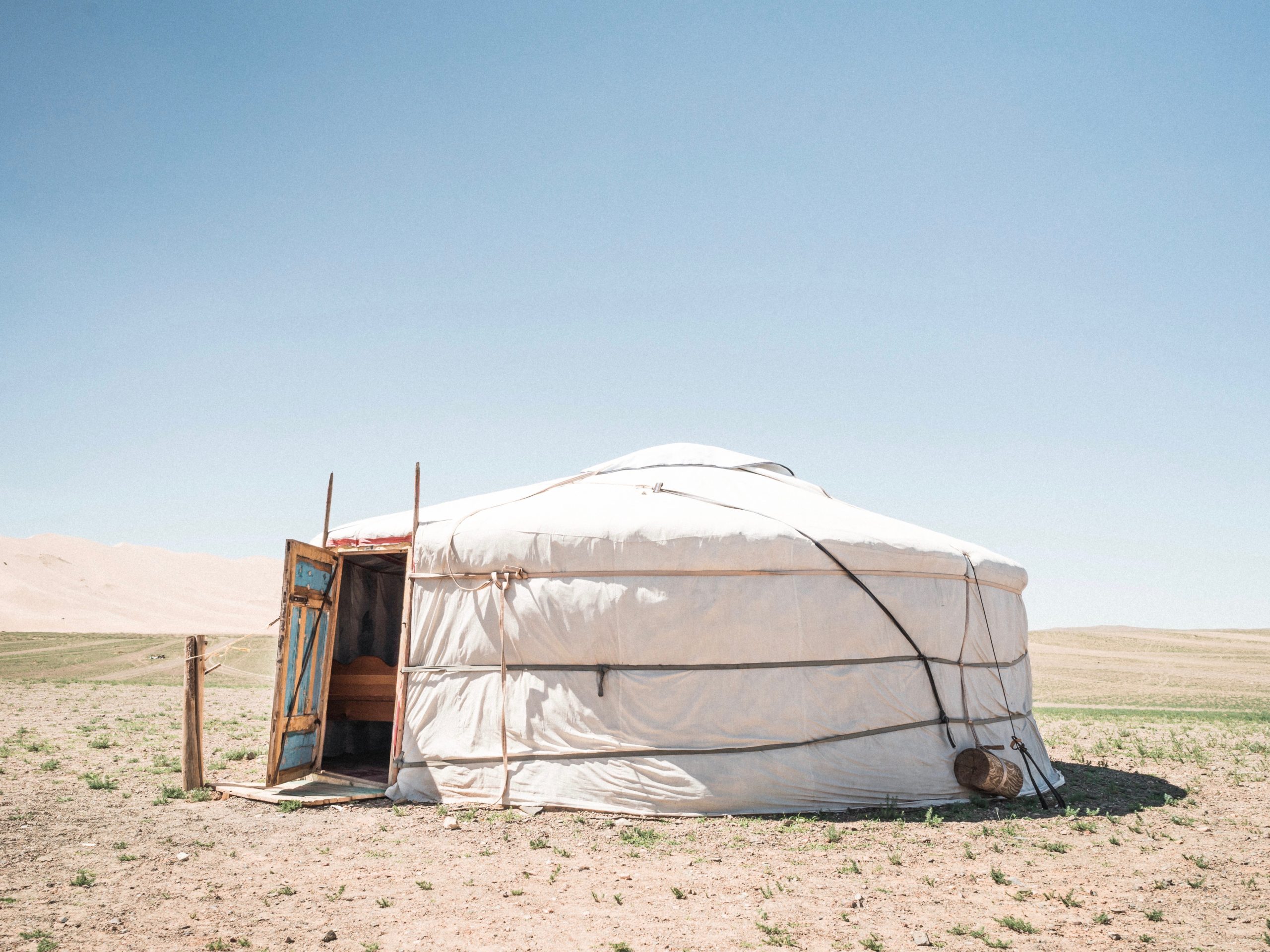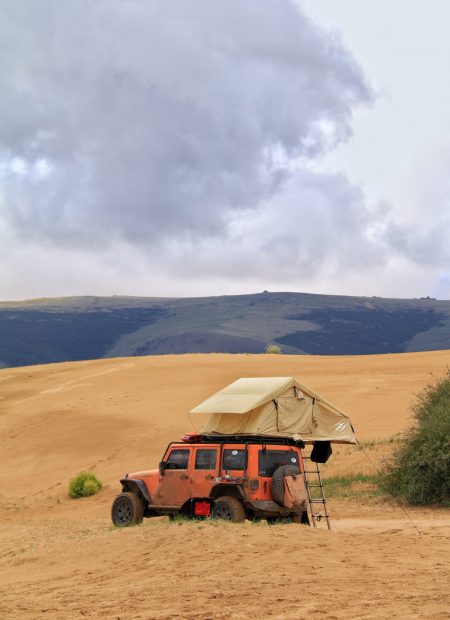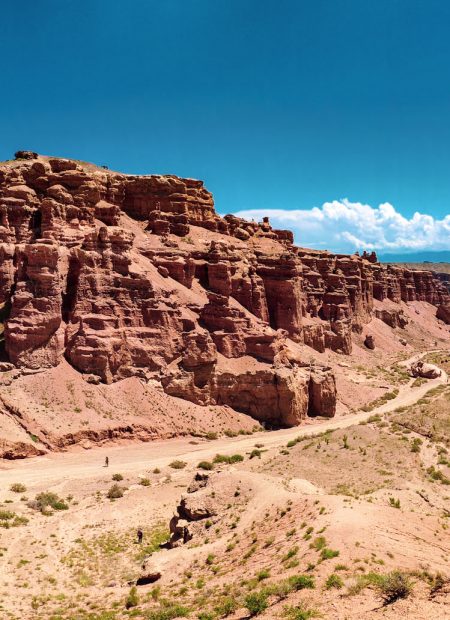
The Essential Guide to Mongolian Ger Etiquette [Updated 2023]
Visiting a nomadic family and curious about their customs? Scared of accidentally offending? Read on for the essential (and fact-checked) guide to Mongolian Ger Etiquette.
“We ground to a bumpy halt in front of a low, round tent. The little orange door was beautifully painted, smoke rose gently from a pipe in the domed roof. A traditional Mongolian ger, home to a nomadic family. It promised comfort, hot tea to warm our hands and the chance to escape from the indecisive weather.”
Although we had expected a nomadic homestay as part of our trip, and read the good old lonely planet, we felt wildly unprepared. Too cold for wild-camping, we had pulled up to the nearest ger to beg hospitality on the first night. Jumping out of the Jeep, the wind chilling us to our bones, our guide casually threw a bunch of instructions at us of what we absolutely shouldn’t do once we were inside.
Most nomadic families have existing relationships with guides and understand that tourists are likely to mess up when it comes to Mongolian ger etiquette. They are naturally quite forgiving of one or two blunders which will most likely be politely ignored or tolerated. But that doesn’t mean that you shouldn’t make an effort!
Firstly, let’s clarify what exactly a Mongolian ger is.

A traditional Mongolia ger in Mongol Els, the Little Gobi
WHAT IS A MONGOLIAN GER?
A Mongolian ger, also known as a yurt, is a traditional portable tent-like dwelling used by the nomadic people of Mongolia. It has a circular wooden frame with lattice walls and a felt or fabric covering, often made from animal skins or wool felt. Inside, a ger typically has a central stove for heating and cooking, and it is decorated with colourful textiles.
The ger is designed to be easily assembled and disassembled. Whilst these tents may be temporary, they are the permanent accommodation type for many in Mongolia. Approximately 50% of Mongolia’s population live a nomadic lifestyle, moving their livestock with the seasons.
Gers are still widely used in Mongolia, both in rural areas and as tourist accommodations, providing a unique experience for travelers wanting to immerse themselves in traditional Mongolian culture.
WAIT, WHAT'S THE DIFFERENCE BETWEEN A GER AND A YURT?
Yurts and gers are very similar. You’ll find these tents all over Mongolia, Kazakhstan, Eastern Russia, and everywhere in-between!
Both terms essentially refer to the same type of structure. “Ger” is the Mongolian term, while “yurt” is the more widely recognized and commonly used term globally. There may be a slight difference in the shape. In a ger, the central peak is supported by two posts and the roof may appear more “domed”. A yurt tends to have a more pointed roof.
However, in Mongolia it is always called a ger. In fact, ger means ‘house’ or ‘home’ in the Mongolian language. The locals take pride in their accommodation, and won’t be shy to correct you if you call it a yurt!
WHAT TO DO WHEN ARRIVING AT A GER
Mongolian nomads are famous for their hospitality. However, if travelling independently, never take advantage of Mongolia’s hospitality by expecting a free night! I recommend always having a tent handy in order to sleep separately from families you encounter if required.
Nomadic families may have a spare ger you can stay in, however you will usually be invited to enter the main family ger to have tea and chat before settling into your own space for the night.
When approaching a Mongolian ger it is customary to say, “Nokhoigo Khorioroi” which means “Hold the dog,” even if you don’t see a dog. Historically it was because guard dogs were common, and may be aggressive. In general, this greeting lets the occupants know that you’re there, so they can come out and greet you.
If you are invited to stay in a family ger it is unlikely you will be expected to pay. You can give a small gift on arrival. Vodka and sweets are good gifts but many families love when you bring gifts from your home country. Children will enjoy colouring books, pens, paper and puzzles. Functional gifts are always welcome, fleeces, head torches, unused toiletries… all things that are hard to come by on the steppe!
Once inside, proceed to the LEFT side of the ger. The right side is for the family only. Women should not sit at the head of the ger (opposite the door), this spot is reserved for the head of the family.

Interior of a traditional ‘spare’ guest ger
MEALTIME GER ETIQUETTE

If you are offered or offering something, you should accept it with your right hand (the left hand in many Asian countries is used for bathroom-related activities!). Use your left hand only to support your elbow if the food is heavy.
Always cut food towards your body, not away, and pass knives by offering the handle.
You will undoubtedly be offered traditional hot-milk tea, fresh off the stove or from a thermos. The tea is made from fresh milk heated with tea-leaves & salt. It is polite to accept & drink at least a small amount before putting it down. It’s not rude to leave it. Hold your tea cup by the bottom, not by the rim.
You will usually be offered fried bread or dried milk curds among other ‘delicacies’. Take at least a nibble of any food offered directly to you. Thankfully, it is not rude to just try it and put it straight down!
DON’T get up in the middle of a meal and walk outside before everyone has finished.
GER ETIQUETTE : WHAT TO DO AND WHAT NOT TO DO
DO
DO relax and make yourself at home – even take a nap if you need. Your hosts will not mind.
Your host may offer to cook for you. It is polite for you to offer to supply some food for the meal, such as biscuits, bread, fruit or pasta.
When offered a glass of vodka dip your left finger into it and flick it towards the sky four times before wiping some on your forehead to honour the sky gods and the four cardinal directions.
Ask permission before photographing your host, their home or their family. Mongolians love being photographed, so remember to take down their name, sum (district) and aimag and mail them a copy.
Use your whole palm to point instead of just your finger.
When sleeping in a ger, point your feet towards the door.
Pack all rubbish out with you.
DON'T
When entering the ger, DO NOT step on the door frame. This is seen as the neck of the ger and stepping on it is believed to ‘strangle the home’
DO NOT walk between the central struts that hold up the ger. It is said that they represent a man and a woman, and coming between them is bad luck for the ger-owning-couple
DON’T whistle in a ger. Whistling is said to summon the wind which isn’t ideal when staying in a structure made from felt and canvas!
DO NOT hold up your fist and twist it to the side, this is a rude gesture basically meaning f**k off.
DON’T put your hat on the floor or move anyone else’s hat.
DO NOT put rubbish on the fire. Shamanism considers fire sacred.
AVOID touching others’ on the head, or with your feet. If you do touch someone with your foot it is polite to offer them a handshake – it’s kind of like a ‘bless you’ after a sneeze
THINGS THAT ARE OK TO DO IN A GER
If it is cold, don’t worry about keeping your warm clothes on. We read that this was rude as it implies the host is not keeping their home warm enough, but it’s absolutely fine. The centre stove in the ger gives off a lot of heat, so if you’re cold, you shouldn’t be for very long!
Advice on Mongolian ger etiquette is limited (hence this post) and there is some confusion about what is and isn’t acceptable. There are over 3000 traditions and customs in Mongolia and these vary depending on who you’re staying with, their religion and beliefs, and which part of the country you’re in.
Most Mongolians will be relaxed about your naïvety and will happily share what’s important to them in their home. Just like you would, if you had expectations of guests (e.g. guests taking their shoes off before coming in). They will be pleasantly surprised if you make an effort with their customs, but the best way to learn is to just go for it!
A NOTE ON HOMESTAYS VS GER CAMPS
Many ger camps are cropping up as tourism in Mongolia increases. Catered to tourists who want to try out the ‘traditional way of living’, they are usually equipped with amenities such as hot showers, bars and restaurants. In tourist ger camps, rules of etiquette don’t apply so much, as you are a paying guest.
For a more traditional experience, we recommend you seek out a nomadic family homestay. The most easy way to arrange this is through your guide, however if you are travelling independently you may encounter nomadic families willing to extend their hospitality to you. Don’t count on this though and always bring your own tent and cooking equipment.
MONGOLIA FAQs
Q: IS MONGOLIA TOURIST FRIENDLY?
A: Certainly! Mongolia is generally tourist-friendly, particularly in popular areas and cities like Ulaanbaatar. English is not widely spoken, but locals are known for their hospitality. If you’re planning to leave the city, you should definitely book onto a guided tour. Respecting local customs and learning basic Mongolian phrases will get you far in making friends.
Q: IS MONGOLIA SAFE TO TRAVEL?
A: Yes, Mongolia is known for its low crime rates and friendly locals. However, it’s advisable to travel with reputable tour operators, especially in remote areas, and be prepared for the challenges of the country’s rugged terrain and variable weather conditions.
Q: IS MONGOLIA EXPENSIVE TO TRAVEL?
A: Mongolia is generally considered an affordable travel destination, especially when compared to Western countries. However, as with any country, the cost of travelling in Mongolia can vary based on your travel style and activities. There are plenty of options for all travel budgets, so don’t worry!
Q: IS MONGOLIA EASY TO TRAVEL?
A: Ehhhh… no. But that’s part of the adventure! Mongolia’s remote areas pose challenges due to limited infrastructure and communication. This is where it’s really important to travel with a guide. They can communicate with locals and navigate like pros, ensuring a smoother journey in this rugged and beautiful country.
Q: IS MONGOLIA VEGETARIAN OR VEGAN FRIENDLY?
A: Mongolian Cuisine isn’t famous for being vegetarian or vegan friendly, but options are improving! You’ll find plenty of veggie and vegan options in Ulaanbaatar (we were pleasantly surprised). Outside of the cities, meat-heavy traditional cuisine may pose a problem for vegetarians. Communicate your needs up-front and they should be able to arrange something. We’ve written a guide to being vegan in Mongolia that you might find helpful.
Q: IS MONGOLIA A TOURIST DESTINATION?
A: Yes, Mongolia is off the beaten path, but does have a good tourism industry. Mongolia offers a range of activities, from exploring the Gobi Desert to trekking in the mountains, making it a diverse and captivating destination for tourists. It’s easy to customise a guided itinerary: check out our six-day itinerary here!
Q: HOW SAFE IS MONGOLIA FOR FEMALE TRAVELLERS?
A: Mongolia is generally safe for female travellers and I had no issues here. Catcalling and harassment didn’t seem like much of a thing, and the men I met were nothing short of respectful. Yes, shit happens everywhere, but the whole country just gave good vibes.
Follow our daily adventures on Facebook and Instagram
Disclaimer: The information and advice provided in this blog are the author’s opinions and based on their personal experiences. All information was accurate at the time of writing. However, things can change quickly, so always double-check current conditions and guidelines before setting out. Remember, your travels and safety are your own responsibility, and this blog can not be held responsible for anything that might happen on your adventures! Always exercise caution and good judgment. Oh, and don’t forget to get travel insurance! Happy travels!
This post may contain affiliate links (yay for transparency!) This means that I will earn a small commission, at no additional cost to you, if you click the link and choose to buy the product. I only link to stuff I have personally bought and found useful and never endorse crap. Your support helps keep the site going, thank you!
Alice
Alice is a UK travel blogger who advocates sustainable travel and being more eco-conscious on a budget. She loves coffee, her houseplants and summiting mountains.
You May Also Like

Southern Mongolia & The Gobi: The Complete Guide
March 13, 2021
Charyn Canyon: The Complete Guide
February 27, 2021
2 Comments
Efrem Tham
Very useful information n as we will be visiting there next week.
Many thanks for the details. Have a wonderful day.
Alice
Ooh, I’m jealous! Have a great trip in Mongolia!